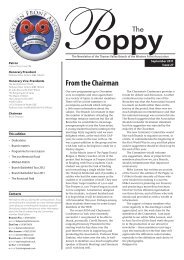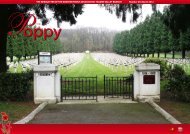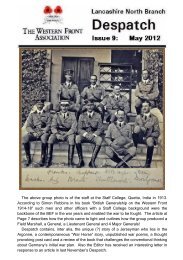The_Poppy_September_2012_Part1.pdf - The Western Front ...
The_Poppy_September_2012_Part1.pdf - The Western Front ...
The_Poppy_September_2012_Part1.pdf - The Western Front ...
Create successful ePaper yourself
Turn your PDF publications into a flip-book with our unique Google optimized e-Paper software.
THE NEWSLETTER OF THE WESTERN FRONT ASSOCIATION, THAMES VALLEY BRANCH Number 30, <strong>September</strong> <strong>2012</strong><br />
<strong>Poppy</strong><br />
THE
Patron<br />
Colonel Terry Cave CBE<br />
Honorary President<br />
Professor Peter Simkins MBE FRHistS<br />
Honorary Vice-Presidents<br />
Dr John Bourne BA PhD FRHistS<br />
Professor Gary Sheffield BA MA PhD FRHistS<br />
Lt.Col. Graham W Parker OBE<br />
André Coilliot<br />
<strong>The</strong> Burgomaster of Ypres<br />
<strong>The</strong> Mayor of Albert<br />
Chairman<br />
Bruce Simpson<br />
CONTENTS<br />
4<br />
13<br />
15<br />
18<br />
21<br />
23<br />
26<br />
3<br />
Bridgeen Fox<br />
From the new Chairman<br />
5 Dedications<br />
Alain Fournier: a mystery solved<br />
Ambulance unit at unknown location<br />
Branch Battlefield tour <strong>2012</strong><br />
Branch Battlefield tour <strong>2012</strong><br />
Programme for <strong>2012</strong>–2-13<br />
Our speakers up to Christmas<br />
Photograph of a field of poppies on<br />
front page taken by Mike Lawson.<br />
2<br />
Contacts<br />
If you are receiving this copy of <strong>The</strong> <strong>Poppy</strong> for the<br />
first time, then please come along to our next branch<br />
meeting on 29th March <strong>2012</strong>. Should you require<br />
directions to the venue or any other information relating<br />
to the branch, please contact one of the committee<br />
members listed below.<br />
Barbara Taylor: tel 01276 32097<br />
or email sandhurst37@tiscali.co.uk<br />
Don Farr: tel 01189 794518<br />
or email don.farr@ntlworld.com<br />
Mike Lawson: tel 01692 535184<br />
or email lawsonm100@aol.com<br />
Roger Laing: tel 01753 654885<br />
or email roger.laing@tiscali.co.uk<br />
Liz Tait: tel 0118 9662885<br />
or email liztait@virginmedia.com
Bridgeen Fox<br />
1932-<strong>2012</strong><br />
It is with the deepest sorrow that we must record that our Branch<br />
Chairman, Bridgeen Fox, sadly passed away suddenly on 4th April <strong>2012</strong>,<br />
following a chronic illness. Our condolences go out to Bridgeen’s family<br />
and friends. A full obituary appeared in the July edition of the <strong>Western</strong><br />
<strong>Front</strong> Association Bulletin No. 93 on page 40.<br />
Bridgeen became Chairman of the Branch following the death<br />
of her husband, former Chairman, Colin Fox way back in 2000 and her<br />
enthusiasm, commitment and devotion to the duties of Chairman will<br />
be sadly missed.<br />
A celebration of Bridgeen’s life, attended by a huge congregation,<br />
took place at Our Lady of Peace, Catholic Church, Earley, Reading on<br />
Monday 23rd April <strong>2012</strong>.<br />
3
From the New Chairman, Barbara Taylor<br />
As the new chairman it falls to me to give an overview<br />
of the last season for the branch. We had some very<br />
interesting talks, with a broad canvas of subjects,<br />
covering all arms; from army, navy and air force to<br />
present day photographs of the <strong>Western</strong> <strong>Front</strong>.<br />
It will be impossible not to mention the sad and<br />
unexpected death of Bridgeen. She was an exceptional<br />
chairman, who always worked very hard to do the best<br />
for the branch and the membership. She will be sadly<br />
missed and for me, an extremely hard act to follow. I am<br />
sure that you have all seen the fine obituary to her in the<br />
recent Bulletin and on the WFA website. Bridgeen strived<br />
tirelessly to assemble a programme of speakers, who<br />
spoke on both interesting and varied subjects.<br />
To that end, my first season and a little beyond,<br />
will be made up mostly of Bridgeen’s forward planning<br />
and as far as that is concerned, I will be resting on her<br />
laurels! So our new programme for the <strong>2012</strong>-13 season is<br />
complete and I believe we will again be treated to some<br />
varied topics; from the volunteers that did the fighting<br />
through to one of the generals and onto Remembrance.<br />
Details of these speakers and their talks are to be found<br />
later in this edition of <strong>The</strong> <strong>Poppy</strong>. As you read this, I<br />
will be working to uphold Bridgeen’s standards for the<br />
remainder of the 2013-14 season.<br />
When Bridgeen died, it was a few days short of the<br />
WFA Annual General Meeting, which it was her habit<br />
to attend; as were the Branch Chairmen’s conferences<br />
and the Armistice Day service at the Cenotaph. I<br />
shall in future, make it my business to attend these<br />
events whenever possible. That will start with the 11th<br />
November ceremony this year. You will have seen details<br />
of this in the last Bulletin No. 93. Indeed, you may have<br />
already had the booking form that is to appear in Stand<br />
To! No. 95 and I should very much like to see as many<br />
members of our branch as possible supporting this<br />
event with me.<br />
Mike Lawson has, as usual, written a full account<br />
of our Branch battlefield tour to the Ypres area in this<br />
edition of <strong>The</strong> <strong>Poppy</strong> and I wish to sincerely thank all of<br />
those people who work hard to make this a success. This<br />
is very much a ‘cooperative’ event and many elements<br />
go to make up the whole; from the planning and<br />
administration to the speakers and their stands. I must<br />
also thank the members who wish to go and this year<br />
we had four new travellers, who I hope got much from<br />
the tour.<br />
We are getting ever nearer to marking the<br />
centenary of the beginning of the Great War and the<br />
Committee would welcome any suggestions regarding<br />
the commemoration of this important anniversary;<br />
especially anything that could be achieved as a branch.<br />
We heard earlier in the year about the research work that<br />
has been done regarding the names on the Wokingham<br />
War Memorial.<br />
As ever, the support of many members who<br />
regularly attend the meetings is much appreciated, as is<br />
the work done by the members of the committee. I am<br />
most grateful to our editor Mike Lawson and to Ann Farr<br />
for all the hard work she puts into the production of our<br />
branch newsletter. I think all must agree that the new<br />
format is even more attractive – especially to those of us<br />
who have signed up to receive it electronically. To this<br />
end can I underline the appeal to those members who<br />
have email to sign up for electronic copies As you all<br />
know postage has gone up hugely this year and this is a<br />
massive, indeed the greatest drain on branch resources.<br />
4
Dedications<br />
As a mark of respect to all those who died on active service during the Great War, the following meetings will be dedicated to the memory of local men or men<br />
serving with the Royal Berkshire Regiment, who died on that corresponding day during 1914‐1918 (except for the special dedication for October). If during your<br />
travels you happen to be near to where any of these soldiers are buried or commemorated then kindly pay a visit.<br />
27th <strong>September</strong><br />
<strong>The</strong> dedication this<br />
month is to Frederick<br />
Jewson, a Company<br />
Sergeant Major with<br />
the 1st Battalion Royal<br />
Berkshire Regiment<br />
from Westminster,<br />
London.<br />
Frederick was<br />
born at St. James,<br />
Westminster in 1882,<br />
the only son of Thomas<br />
C.S.M. Frederick Jewson<br />
1st Bn. Royal Berkshire Regiment and Sarah Jewson<br />
of 2 Dufour’s Place,<br />
Westminster. He had a younger sister Beatrice (born<br />
1886) and the family of four lived in a single room<br />
apartment, in the heart of Soho, near Carnaby Street.<br />
His father worked as a night porter at Covent Garden<br />
Market and his mother worked locally as a laundress.<br />
Sometime during the late 1890s, Frederick left the<br />
cramped family home in the centre of London and<br />
enlisted with the Royal Berkshire Regiment in Reading.<br />
By 1911, he had been promoted to the rank of<br />
Sergeant with the 1st Battalion and in April 1911, now<br />
age 29, he was serving with the battalion at South<br />
<strong>Front</strong> Barracks, <strong>Western</strong> Heights, Dover.<br />
In the early summer of 1914, the 1st Battalion was<br />
based at Mandora Barracks, Aldershot, on routine<br />
peace-time soldiering but with tension mounting<br />
in Europe following the assassination of Arch-Duke<br />
Ferdinand in Sarajevo, the battalion began to mobilise<br />
for war in late July 1914. Mobilisation was almost<br />
complete by 6th August 1914 and the 1st Battalion<br />
was allocated to form part of 6th Infantry Brigade,<br />
together with the 1st Battalion King’s (Liverpool)<br />
Regiment, 2nd Battalion South Staffordshire Regiment<br />
and 1st Battalion Kings Royal Rifle Corps in the 2nd<br />
Infantry Division.<br />
Following an inspection by King George V and<br />
Queen Mary on 11th August 1914, the battalion<br />
boarded two trains at Farnborough Station for<br />
Southampton on 12th August 1914, and embarked on<br />
two transport ships, SS Ardmore and SS Mellifont for<br />
Rouen, landing on 13th August 1914.<br />
5<br />
No. 4 Casualty Clearing Hospital, Braine Chateau<br />
After a couple of days the men boarded a train<br />
for Wassigny, before marching to camp at Vénérolles,<br />
south-east of Le Cateau, for intensive training. On the<br />
21st August 1914 the battalion marched 11 miles to<br />
Landrecies before crossing the Belgian border and<br />
entrenching in fields around Vellereille-le-Sec, five<br />
miles south-east of Mons, where they came under<br />
enemy artillery action for the first time. Orders were<br />
received on 24th August 1914 to retire and the ‘Retreat<br />
from Mons’ had started.
During the retreat the battalion fought its first<br />
major action of the war at Maroilles, on 25th/26th<br />
August 1914, suffering losses of 63 men killed,<br />
wounded or missing, including Major Turner taken<br />
prisoner and Capt. Henry Shott, the first officer of the<br />
Royal Berkshires to be killed in the Great War. <strong>The</strong><br />
retreat to the Marne and beyond continued and by<br />
5th <strong>September</strong> 1914 the battalion had marched a total<br />
of 236 miles in 15 days but by now the retreat was<br />
over as the BEF regrouped, turned northwards and<br />
embarked on the offensive.<br />
On 9th <strong>September</strong> 1914, the 1st Battalion recrossed<br />
the Marne at Charly-sur-Marne, near Château<br />
Thierry and by 13th <strong>September</strong> 1914 had reached<br />
the Aisne, to cross it on a pontoon bridge near Soupir.<br />
However, by now it had become apparent that the<br />
enemy had stopped retreating and was setting up a<br />
defence line on the Chemin des Dames. <strong>The</strong> advance<br />
of the BEF was halted and a front line was established<br />
here to mark the beginning of trench warfare, a<br />
stalemate that was to continue for the next four years.<br />
<strong>The</strong> 1st Battalion set up its HQ at La Metz Farm and<br />
was engaged in heavy fighting along the Oise-Aisne<br />
Canal for the next seven days, until relieved by the 1st<br />
Battalion, Rifle Brigade on 22nd <strong>September</strong> 1914.<br />
During these seven days the battalion incurred<br />
losses of 18 men killed and 98 men wounded<br />
including C.S.M. Frederick Jewson, who, sadly, died of<br />
his wounds, on 27th <strong>September</strong> 1914, age 32, most<br />
probably at No. 4 Casualty Clearing Hospital, situated<br />
in Braine Château.<br />
6260 C.S.M. Frederick Jewson is buried in Braine<br />
Communal Cemetery, Braine, Aisne, France but is<br />
commemorated on a special memorial (A. 21), as the<br />
exact position of his grave within the Commonwealth<br />
plot is not known.<br />
<br />
October<br />
<strong>The</strong> dedication this month is to Frederick William<br />
Fenne, a Company Sergeant Major with the 1st<br />
Battalion Duke of Cornwall’s Light Infantry from<br />
Bodmin, Cornwall.<br />
Frederick William Fenne is the great-uncle of<br />
branch member Ian Fenne and was born at Fulham<br />
in the spring of 1882. He was third eldest of eleven<br />
children born to Frederick Henry Fenne, a gas stoker<br />
and Charlotte Caroline Fenne of 27 Imperial Cottages,<br />
Fulham, London. His parents were both of German<br />
descent. Frederick Henry was born at Hanover,<br />
Germany in 1847 and Charlotte Caroline was born at<br />
Whitechapel, London in 1859 with the maiden name<br />
of Wagner.<br />
By 1891 the family had moved to 4 Edith Road,<br />
Fulham where young Frederick William, age 9, was<br />
a pupil at a local school. Unfortunately, Frederick’s<br />
service record has not survived but prior to 1901 but<br />
possibly around 1898/99, he enlisted with the army in<br />
C.S.M Frederick Fenne, 1st Bn. Duke of Cornwall’s Light Infantry<br />
with his wife Henrietta and son, Frederick, taken on<br />
20th October 1912<br />
London and was later posted to the 2nd Bn Duke of<br />
Cornwall’s Light Infantry at Victoria Barracks, Bodmin,<br />
Cornwall.<br />
Under the Childers Reforms (1881) system, one<br />
regular battalion of each regiment was to be at a<br />
“home” station, whilst the other was to be abroad.<br />
6
Every few years, there was to be an exchange of<br />
battalions, so between 1888 and 1900, the 2nd Bn<br />
Duke of Cornwall’s Light Infantry was at ”home” in<br />
England and Ireland, whilst the 1st Battalion was<br />
stationed abroad in India and Burma. However, at the<br />
outbreak of the Boer War on 11th October 1899, the<br />
2nd Battalion was sent to South Africa, where it arrived<br />
the following month and took part in minor actions<br />
on the western border of the Cape Colony. In February<br />
1900, it became part of 19th Brigade and saw action<br />
against the Boers at Paardeburg and in March 1900<br />
entered Bloemfontein. It continued to take part in a<br />
series of skirmishes until the end of the war on 31st<br />
May 1902. However, the 1st Battalion took no part<br />
on the war but moved from India to Ceylon in 1900,<br />
where it guarded South African prisoners-of-war.<br />
<strong>The</strong> census return of 1901 for the Fenne family at 4<br />
Edith Road, Fulham lists Frederick William as a soldier,<br />
age 19, but it is possible that if he had been posted<br />
to the 2nd Battalion by that time, then he could have<br />
served in South Africa during the Boer War.<br />
Following the war in South Africa, the system<br />
of rotating battalions between home and foreign<br />
stations resumed and between 1902 and 1905, the<br />
2nd Battalion was posted “home” to Bodmin. It is<br />
probable, that Frederick met his future wife, Henrietta<br />
Elizabeth Frazier whilst stationed here in Cornwall.<br />
Henrietta was born in Kennington, London during<br />
the summer of 1886 to William and Henrietta Frazier<br />
<strong>The</strong> Castle of Good Hope, Cape Town<br />
of 312 Kennington Road, Lambeth, London. She was<br />
the eldest of six children but by 1901 the family had<br />
moved to Railway Terrace, Berrycombe Road, Bodmin.<br />
With the 1st Battalion returning home in 1905,<br />
the 2nd Battalion was dispatched to Gibraltar, where<br />
it remained until 1907, before being given a direct<br />
posting to Bermuda, where it stayed until 1910. It<br />
was during this period, that Henrietta, age 23, sailed<br />
for Bermuda in 1909 to marry Frederick, age 27, and<br />
become an army wife.<br />
From Bermuda, the 2nd Battalion was sent to South<br />
Africa and were stationed at the Castle of Good Hope,<br />
Cape Town. By now Frederick had been promoted to<br />
the rank of Sergeant and it was here in South Africa<br />
that their first child, a son, Frederick William Henry was<br />
born, in 1911.<br />
<strong>The</strong> battalion left South Africa for Hong Kong in<br />
1913 but returned home following the outbreak of<br />
war on 4th August 1914 and arrived home on 13th<br />
November 1914 to be allocated to 82nd Brigade in<br />
27th Division at Magdalen Hill Camp, near Winchester<br />
on 17th November 1914. After five weeks training the<br />
battalion embarked for France from Southampton<br />
and landed at le Havre on 21st December 1914, to<br />
concentrate in an area around Aire and Arques by<br />
Christmas Day 1914. During 1915 both the 1st and<br />
2nd Battalions fought at the Second Battles of Ypres<br />
before the 2nd Battalion left the <strong>Western</strong> <strong>Front</strong> for<br />
Salonika, on 27th November 1915.<br />
It is not known when Frederick, now promoted to<br />
Company Sergeant Major, was transferred to the 1st<br />
Battalion Duke of Cornwall’s Light Infantry. It could<br />
have been between the South Africa and Hong Kong<br />
postings, as the photograph of Frederick and his<br />
family taken in October 1912 certainly looks to have<br />
been taken at home in England. Alternatively, it could<br />
have been before to the 2nd Battalion’s departure for<br />
Northern Greece at the end of November 1915.<br />
During the autumn of 1915, a second son, Berkeley<br />
Charles Leslie, was born to Frederick and Henrietta<br />
at St. Nicholas Street, Bodmin. <strong>The</strong> birth of Berkeley,<br />
at this time, may possibly be part of the reason for<br />
Frederick’s transfer to the 1st Battalion in France,<br />
instead of being sent to Salonika with the 2nd<br />
Battalion.<br />
Berkeley, named after Henrietta’s younger brother,<br />
served as a Signalman with the Royal Corps of Signals<br />
in India during the Second World War but sadly died<br />
7
4th Bn Royal Fusiliers at Mons on 22nd August 1914<br />
Action at Reutel on 4th October 1917<br />
on 7th May 1942, age 26. He is buried in Kirkee War<br />
Cemetery, grave 8.B.8, approximately 100 miles southeast<br />
of Mumbai.<br />
On mobilisation at the outbreak of war, the 1st<br />
Battalion was stationed at <strong>The</strong> Curragh but left Ireland<br />
on 7th August 1914 to land in France at le Havre on<br />
13th August 1914. Forming part of 14th Brigade in 5th<br />
Division the 1st Battalion concentrated with the rest<br />
of the Division around Landrecies between 16th and<br />
20th August 1914. During 1914 the Division took part<br />
in the Retreat from Mons at Mons (23rd-24th August),<br />
Élouges (24th August), le Cateau (26th August)<br />
and Crépy-en-Valois (1st <strong>September</strong>). <strong>The</strong> Division<br />
then saw action in the Battle of the Marne (6th-9th<br />
<strong>September</strong>) and the Battle of the Aisne (13th-20th<br />
<strong>September</strong>) before arriving in Flanders to take part in<br />
the Battles of la Bassée (10th October-2nd November),<br />
First Ypres (5th-19th November) and Nonne Bosschen<br />
(11th November). During the spring of 1915 the<br />
Division was engaged in the Capture of Hill 60 (17th-<br />
22nd April), the Second Battle of Ypres (23rd April-1st<br />
May), Gravenstafel Ridge (23rd April) and St. Julien<br />
(24th April-5th May).<br />
Following a restructuring on 12th January 1916,<br />
the 1st Battalion was transferred from 14th Brigade<br />
in 5th Division to a re-designated 95th Brigade in<br />
the same division. <strong>The</strong> newly formed Brigade saw<br />
action during 1916, in the Battles of the Somme at<br />
High Wood (20th-25th July), Guillemont (3rd-6th<br />
<strong>September</strong>), Flers-Courcelette (18th-22nd <strong>September</strong>)<br />
and Morval (25th-26th <strong>September</strong>). In the spring<br />
8
of 1917, the Brigade fought in the Battles of Arras at<br />
Vimy Ridge (9th-14th April), la Coulotte (23rd April),<br />
the Third Battle of the Scarpe (3rd-4th May) and Oppy<br />
Wood (28th June).<br />
During the Third Battle of Ypres the 1st Battalion<br />
was in billets at Méteren on 1st October 1917, training<br />
for the forthcoming attack on the Broodseide Ridge<br />
on 4th October 1917. Enemy aircraft were very active<br />
dropping bombs on the outskirts of the town but no<br />
casualties were sustained.<br />
On the 2nd October about 130 bombs were<br />
dropped on the transport line killing four men and<br />
wounding seven others with two horses killed. <strong>The</strong><br />
battalion left Méteren at 7.00 a.m. and after a long<br />
journey, including a lengthy period of rest, reached<br />
the reserve position in Sanctuary Wood at 7.30<br />
p.m. Soon after arriving, the enemy put down a<br />
heavy barrage between 8.00 p.m. and 9.00 p.m. but<br />
fortunately no serious damage was done.<br />
During the 3rd October, the battalion remained<br />
in Sanctuary Wood, under intermittent shelling, for<br />
most of the day before moving off to relieve the 1st<br />
East Surrey Regiment in the front line at 7.30 p.m.<br />
<strong>The</strong> operation was carried successfully and despite<br />
encountering a heavy barrage at Black Watch Corner,<br />
the battalion formed up in the assembly trenches by<br />
11.30 p.m. for the forthcoming assault.<br />
<strong>The</strong> dispositions of the battalion for the attack were<br />
as follows:<br />
Right Boundary - Jut Farm<br />
Left Boundary - Reutel - Black Watch Corner Road<br />
Battalion HQ – Pill Box at Cameron House<br />
Right Assaulting Coy – ‘A’ Coy (2nd/Lt. G.F. Clarke)<br />
Left Assaulting Coy – ‘B’ Coy (Capt. R.H.<br />
Hughendon)<br />
Close Support Coy – ‘D’ Coy (Capt. J.N. Baines)<br />
Reserve Coy – ‘C’ Coy (2nd/Lt. B Dench) 100 yards<br />
east of Cameron House<br />
<strong>The</strong> night passed quietly except for odd shelling<br />
and hostile machine gun fire that mortally wounded<br />
2nd/Lt. G.F. Clarke at around midnight. Command of<br />
‘A’ Coy was taken over by 2nd/Lt. G.P. Crouch at about<br />
5.15 a.m. and Lt.-Col. C.B. Norton went round the<br />
assembly position to see all company commanders<br />
before the attack.<br />
At 5.30 a.m. the enemy opened up a heavy barrage<br />
on the back areas and assembly positions but at 6.00<br />
a.m. the divisional artillery countered that made the<br />
hostile enemy barrage appear feeble by comparison.<br />
<strong>The</strong> assaulting waves went over in perfect<br />
formation at 6.00 a.m. but met considerable<br />
opposition from infantry machine guns and pill boxes<br />
in Cameron Covert. Coupled with enfilade fire from<br />
Polderhoek Château, this opposition delayed the<br />
assaulting waves and they lost touch with our barrage.<br />
After severe fighting, the enemy was driven<br />
from Cameron Covert with 200 prisoners taken and<br />
15 machine guns captured. Great assistance was<br />
rendered during the latter stages of the attack by<br />
three tanks that came along the Reutel Road. No<br />
further opposition was encountered from enemy<br />
infantry until the final objective on Juniper Hill was<br />
reached, when it was found impossible to consolidate<br />
the third portion of the objective due to enfilade<br />
machine gun fire and accurate artillery caused<br />
by direct observation from the Château Spur. <strong>The</strong><br />
remnants of assaulting companies kept in touch with<br />
the Brigade on our left and side-stepped to the north<br />
of the Reutel Road.<br />
From 7.30 a.m. onwards the enemy barrage<br />
became very heavy. No definite news was being<br />
received at HQ from the companies due to the<br />
majority of the officers becoming casualties and<br />
runners being either killed or wounded by machine<br />
gun fire of shelling.<br />
Hostile artillery fire continued intensely for the<br />
next 13 hours but slackened off between 6.00 p.m.<br />
and 7.00 p.m. Enemy machine gun also slackened<br />
at about 7.00 p.m. that allowed Lt.-Col. C.B. Norton<br />
to make a personal reconnaissance of the objective<br />
line. He discovered that a gap of about 400 yards had<br />
been established between remnants of the battalion’s<br />
companies in touch with 21st Division on the left and<br />
the battalion on the right south of the Reutel Beek.<br />
To cover this gap all available troops in the vicinity of<br />
Cameron House, around 150 men, were formed up on<br />
the line of the original assembly position.<br />
9
Information had been received from 21st Division,<br />
earlier in the day at about 3.00 p.m. that the enemy<br />
were seen to be reinforcing the Polderhoek Château.<br />
At 9.35 p.m. and 12.35 p.m., S.O.S signals were sent<br />
up on the flanks to warn of possible counter attacks<br />
but as far as could be ascertained no serious attacks<br />
developed and the very dark night passed away fairly<br />
quietly.<br />
At dawn on 5th October the enemy artillery was<br />
exceptionally quiet and the troops in the assembly<br />
trenches advanced under the command of Lt.-Col. C.B.<br />
Norton and Capt B.M. Taylor to clear up the situation<br />
in Cameron Covert and formed a line running southwest<br />
from the Reutel Road towards the position held<br />
by troops of the 15th Bn Durham Light Infantry of 21st<br />
Division on the right to the south of Reutel Beek.<br />
Casualties for the 1st Bn Duke of Cornwall’s Light<br />
Infantry during this action on 4th October 1917<br />
proved very costly with six officers and 112 other<br />
ranks killed and many more were wounded.<br />
Sadly one of those killed that day was 5961 C.S.M<br />
Frederick William Fenne, age 25. His body was never<br />
recovered and he is commemorated on the Tyne Cot<br />
Memorial, Zonnebeke, West-Vlaanderen, Belgium,<br />
panel 80 to 82 and 163A.<br />
Footnote:<br />
Tragically, Frederick was not the only member of the<br />
Fenne family to be killed during the Great War.<br />
On 11th November 1914, Frederick’s younger<br />
brother, Pte. Albert William Fenne, 4th Bn Royal Fusiliers<br />
(9th Brigade, 3rd Division) was killed in action, age 27, at<br />
Gheluvelt in the Battle of Nonne Bosschen. Albert was in<br />
the same battalion as Lt. Maurice Dease and Pte. Sidney<br />
Godley, when they won the first VCs of the war at Nimy<br />
during the Battle of Mons.<br />
Ironically, Albert was killed just a few hundred yards<br />
away from the spot where his older brother Frederick<br />
was killed almost three years later. Like Frederick, Albert’s<br />
body was never recovered and he is commemorated on<br />
the Ypres (Menin Gate) Memorial, Ieper, West-Vlaanderen,<br />
Belgium, panel 6 and 8.<br />
29th November<br />
<br />
<strong>The</strong> dedication this<br />
month is to George<br />
Abery, a Driver with the<br />
35th Division, Signal Coy,<br />
Royal Engineers from<br />
Reading.<br />
George Abery was<br />
born at Reading in the<br />
early part of 1898 to<br />
William Abery, a light<br />
engine driver and Annie<br />
Abery, a nurse of 16<br />
Chester Street, Reading.<br />
He was the youngest of five children having three<br />
older brothers, William, Henry and Frederick and an<br />
elder sister, Amelia. By 1911, the family had moved<br />
to 45 Grange Avenue, Reading with the exception of<br />
Henry, who had left home to join the Royal Navy, as a<br />
stoker, at Portsmouth.<br />
In 1915, the family were living at 54 De Beauvoir<br />
Road, Reading, near Cemetery Junction, where George<br />
was working as a porter before enlisting at Reading on<br />
27th March 1915, age 17, as a driver with the original<br />
39th Division, Signal Coy (Reading), Royal Engineers.<br />
George was transferred to the re-designated 35th<br />
(Bantam) Division, Signal Coy, Royal Engineers on<br />
27th July 1915 and sent to North Yorkshire for training<br />
before the Division moved south to Salisbury Plain<br />
around Marlborough, Chiseldon and Cholderton.<br />
On 18th January 1916, the Signal Coy embarked for<br />
France and by 6th February 1916, all units of the 35th<br />
Division had completed their concentration in base<br />
camps east of St. Omer.<br />
In July and August of 1916 the Division fought in<br />
the Battles of the Somme at Bazentin Ridge (15th-17th<br />
July), Arrow Head Copse and Maltzhorn Farm (19th-<br />
30th July) and Falfemont Farm (19th-26th August).<br />
Following a critical report on the low physical and<br />
moral standard of the infantry in the Division by the<br />
G.O.C. on 8th December 1916, it was re-organised,<br />
in early 1917, to become a non-Bantam Division. A<br />
total of 2,784 men were rejected and transferred to<br />
10


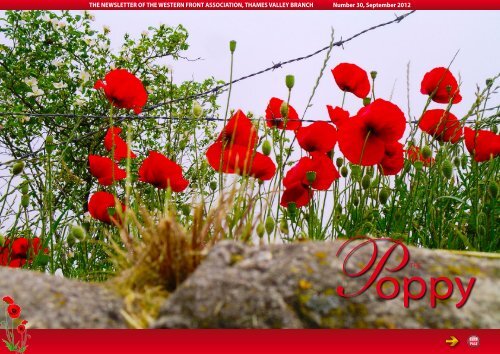
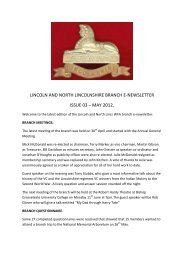
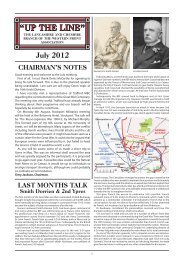
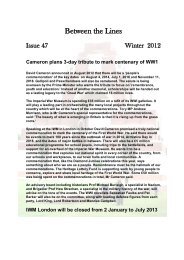

![Fromelles Australian Working List[1].pdf - The Western Front ...](https://img.yumpu.com/29972632/1/184x260/fromelles-australian-working-list1pdf-the-western-front-.jpg?quality=85)
